spare wheel BUICK REGAL 1996 Owners Manual
[x] Cancel search | Manufacturer: BUICK, Model Year: 1996, Model line: REGAL, Model: BUICK REGAL 1996Pages: 356, PDF Size: 17.97 MB
Page 213 of 356
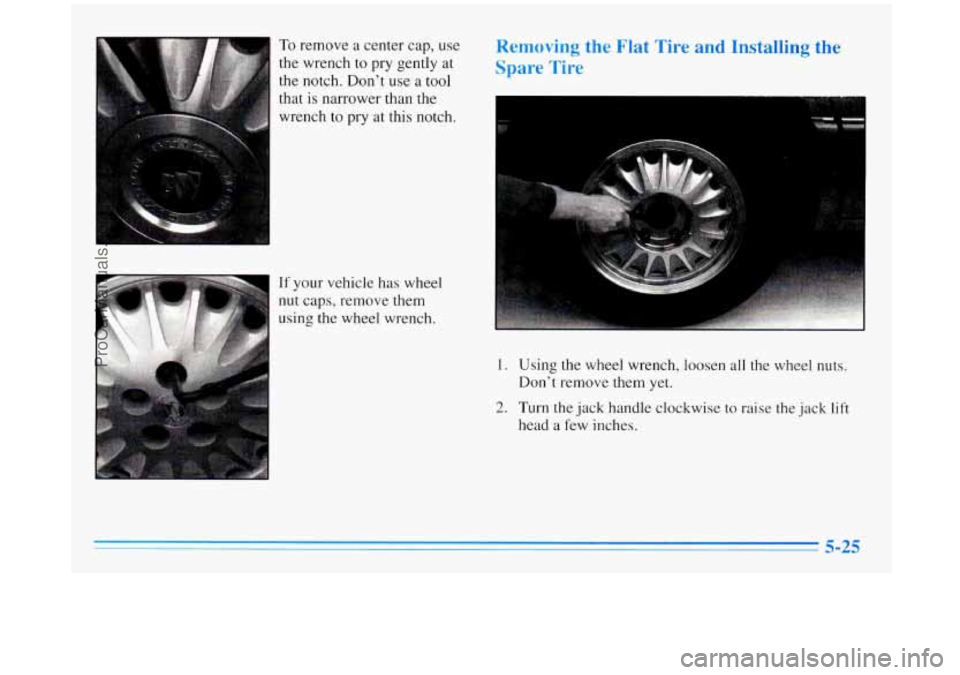
To remove a center cap, use
the wrench
to pry gently at
the notch. Don’t use
a tool
that is narrower than the
wrench to pry at this notch.
If your vehicle has wheel
Removing the Flat Tire a]
Spare Tire
LP the
1. Using the wheel wrench, loosen all the wheel nuts.
Don’t remove them yet.
2. Turn the jack handle clockwise to raise the jack lift
head
a few inches.
- 5-25
ProCarManuals.com
Page 215 of 356
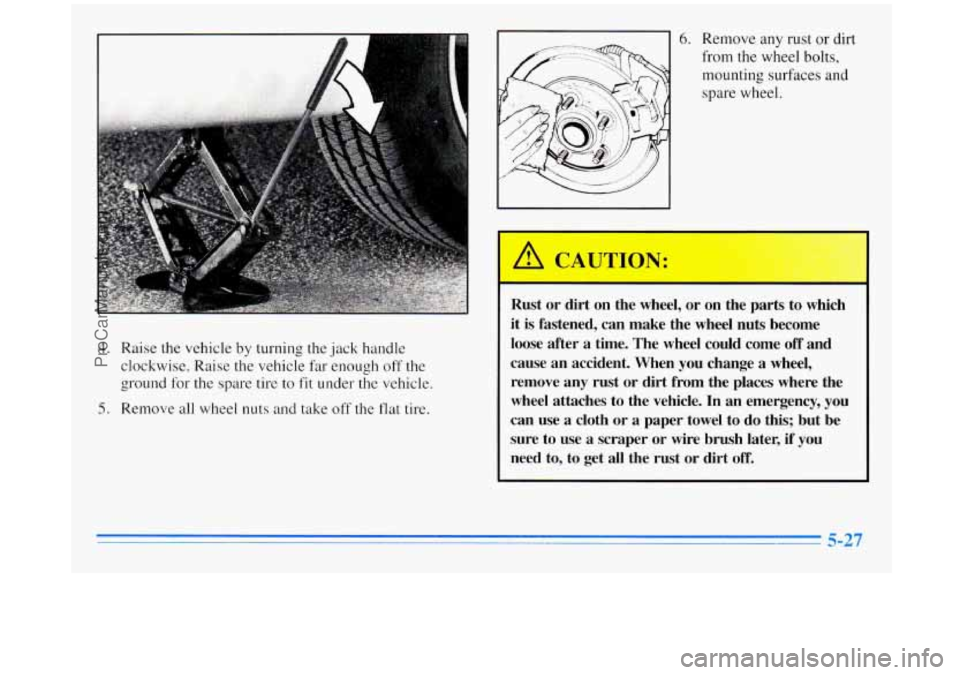
4. Raise the vehicle by turning the jack handle
clockwise. Raise the vehicle far enough off the
ground for the spare tire
to fit under the vehicle.
5. Remove all wheel nuts and take off the flat tire.
6. Remove any rust or dirt
from the wheel bolts,
mounting surfaces and
spare wheel.
A CAUTION:
I
~ Rust or dirt on the wheel, or on the parts to which
it is fastened, can make the wheel nuts become
loose after a time. The wheel could come
off and
cause an accident. When you change
a wheel,
remove any rust or dirt from the places where the
wheel attaches to the vehicle. In an emergency, you
can use a cloth
or a paper towel to do this; but be
sure to use
a scraper or wire brush later, if you
need to, to get all the rust or dirt
off.
ProCarManuals.com
Page 217 of 356
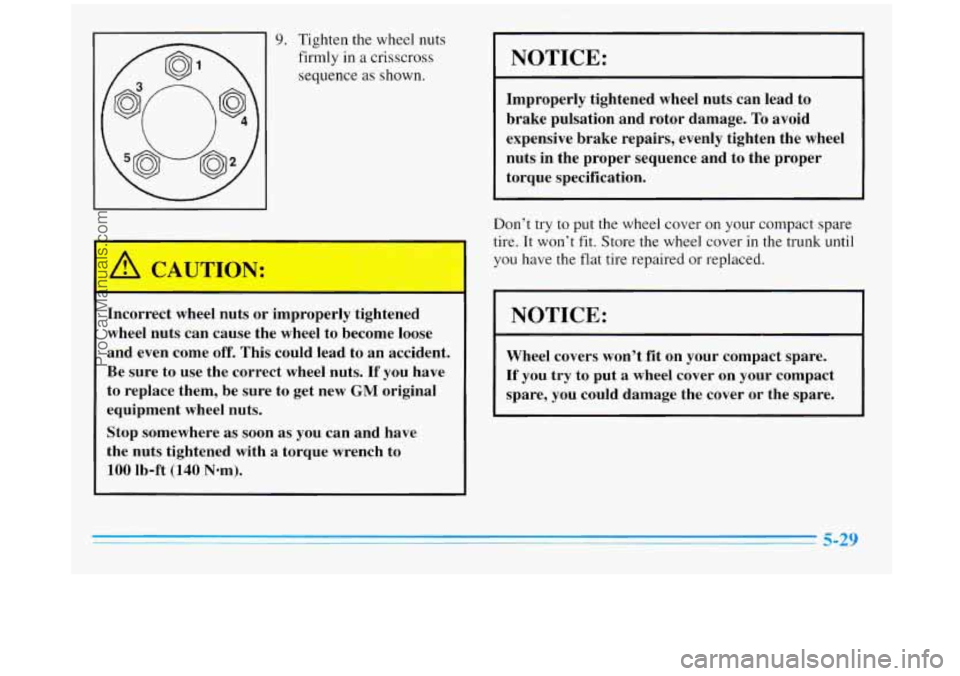
9. Tighten the wheel nuts
firmly in a crisscross
sequence as shown.
I
Incorrect wheel nuts or improperly tightened
wheel nuts can cause the wheel to become loose
and even come
off. This could lead to an accident.
Be sure to use the correct wheel nuts.
If you have
to replace them, be sure to get new
GM original
equipment wheel nuts.
Stop somewhere
as soon as you can and have
the nuts tightened with a torque wrench to
100 lb-ft (140 Nom).
NOTICE:
Improperly tightened wheel nuts can lead to
brake pulsation and rotor damage. To avoid
expensive brake repairs, evenly tighten the wheel nuts in the proper sequence and to the proper
torque specification.
Don‘t try
to put the wheel cover on your compact spare
tire. It won’t
fit. Store the wheel cover in the trunk until
you have the flat tire repaired or replaced.
NOTICE:
~
~~
Wheel covers won’t fit on your compact spare.
If you try to put a wheel cover on your compact
spare, you could damage the cover
or the spare.
ProCarManuals.com
Page 218 of 356
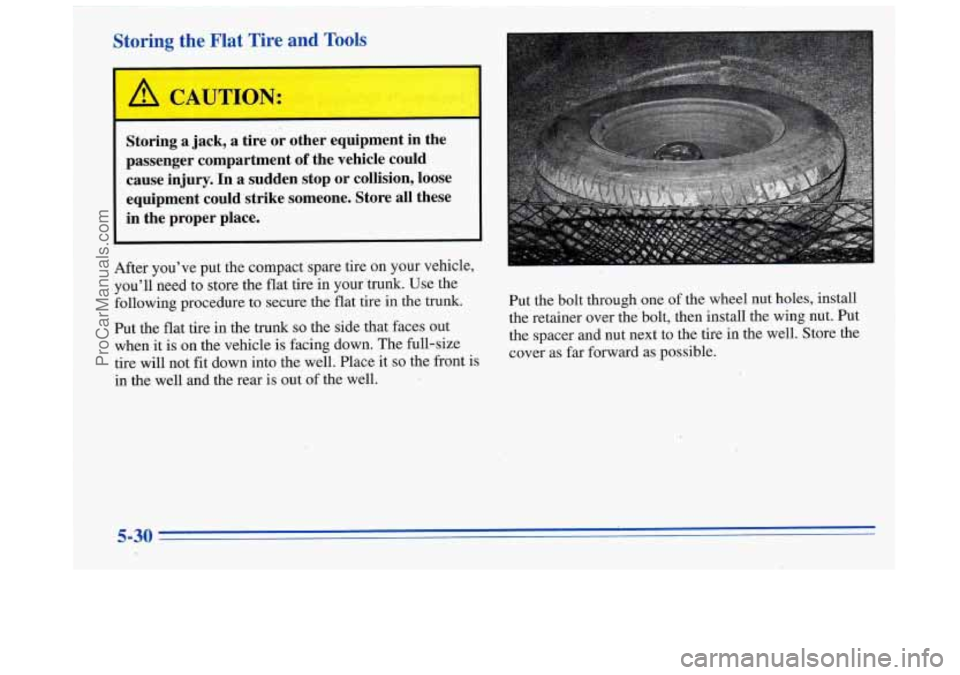
Storing the Flat Tire and Tools
~~
F< .&.ye ~ __
Storing a jack, a tire or other equipment in the
passenger compartment
of the vehicle could
cause injury. In a sudden stop or collision, loose
equipment could strike someone. Store all these
in the proper place.
After you’ve put the compact spare tire on your vehicle,
you’ll need to store the flat tire in your trunk. Use the
following procedure
to secure the flat tire in the trunk.
Put the flat tire in the trunk
so the side that faces out
when it is on the vehicle is facing down. The full-size
tire will not fit down into the well. Place it
so the front is
in the well and the rear is out of the well. Put the bolt through
one of the wheel nut holes, install
the retainer over the’bolt, then install the wing nut. Put
the spacer and nut next to the tire in the well. Store the
cover as far forward as possible.
5-30
ProCarManuals.com
Page 220 of 356
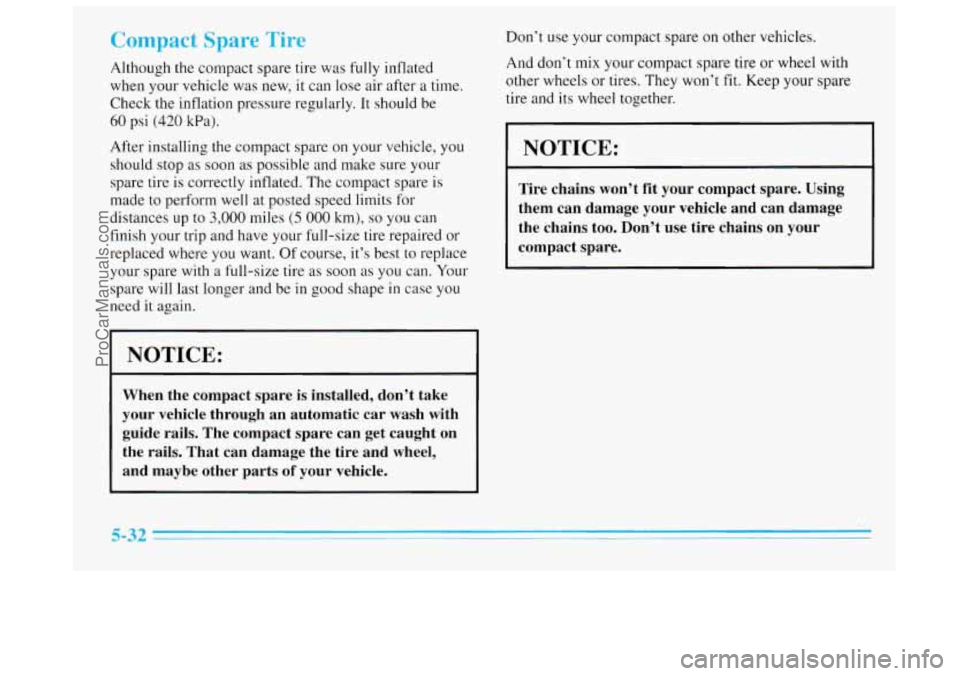
Con 1ct 5 Tirt
Although the compact spare tire was fully inflated
when your vehicle
was new, it can lose air after a time.
Check the inflation pressure regularly. It should be
60 psi (420 kPa).
After installing the compact spare on your vehicle, you
should
stop as soon as possible and make sure your
spare tire is correctly inflated. The compact spare is
made to perform well at posted speed limits for
distances up to
3,000 miles (5 000 km), so you can
finish your trip and have your full-size tire repaired or
replaced where
you want. Of course, it’s best to replace
your spare with
a full-size tire as soon as you can. Your
spare will last longer and be in good shape in case
you
need it again.
NOTICE:
When the compact spare is installed, don’t take
your vehicle through an automatic car wash with
guide rails. The compact spare can get caught on
the rails. That can damage the tire and wheel,
and maybe other parts
of your vehicle. Don’t use your
compact spare on other vehicles.
And don’t mix your compact spare tire or wheel with
other wheels or tires. They won’t
fit. Keep your spare
tire and its wheel together.
NOTICE:
Tire chains won’t fit your compact spare. Using
them can damage your vehicle and can damage
the chains too. Don’t use tire chains
on your
compact spare.
ProCarManuals.com
Page 258 of 356

NOTICE: (Continued)
If your tires have too much air (overinflation),
you can get the following:
Unusual wear
0 Bad handling
Rough ride
Needless damage from road hazards.
When
to Check
Check your tires once a month or more.
Don’t forget your compact spare tire.
It should be
at
60 psi (420 kPa).
How to Check
Use a good quality pocket-type gage to check tire
pressure. You can’t tell if
your tires are properly inflated
simply by looking at them. Radial tires may look
properly inflated even when they’re underinflated.
Be sure
to put the valve caps back on the valve stems.
They help prevent leaks
by keeping out dirt and moisture.
Tire Inspection and Rotation
Tires should be inspected every 6,000 to 8,000 miles
(10
000 to 13 000 km) for any signs of unusual wear.
If unusual wear is present, rotate your tires
as soon as
possible and check wheel alignment. Also check for
damaged tires or wheels. See “When It’s Time for New
Tires” and “Wheel Replacement” later in this section for
more information.
The purpose of regular rotation is to achieve more
uniform wear for all tires on the vehicle.
The first
rotation is the most important. See “Scheduled
Maintenance Services”
in the Index for scheduled
rotation intervals.
6-36
ProCarManuals.com
Page 259 of 356
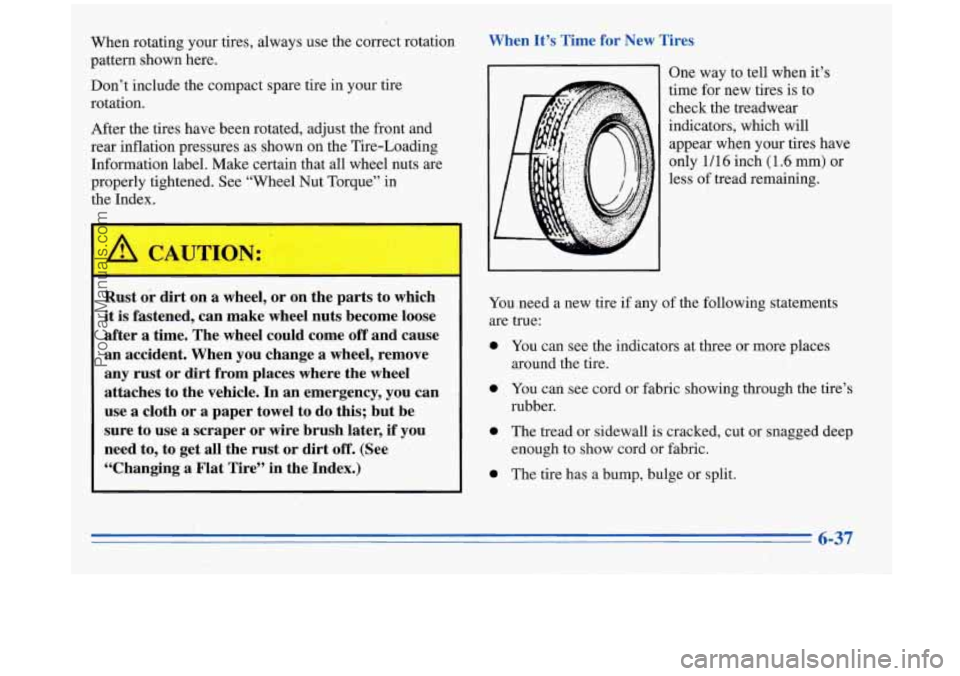
When rotating your tires, always use the correct rotation
pattern shown here.
Don’t include the compact spare tire in your tire
rotation.
After the tires have been rotated, adjust the front and
rear inflation pressures as shown on the Tire-Loading
Information label. Make certain that all wheel nuts are
properly tightened. See “Wheel Nut Torque” in
the Index.
Rust or dirt on a wheel, or on the parts to which
it is fastened, can make wheel nuts become loose
after a time. The, wheel could come
off and cause
an accident. When you change
a wheel, remove
any rust or
dirt from.places where the wheel
attaches to the vehicle. In an emergency, you can
use a cloth or a paper towel to
do this; but be
sure to use a scraper or wire brush later,
if you
need to, to get
all the rust or dirt off. (See
“Changing a Flat Tire” in the Index.) When
It’s Time for New Tires
One way to tell when it’s
time for new tires is to
check the treadwear
indicators, which will
appear when your tires have
only
1/16 inch (1.6 mm) or
less of tread remaining.
You, need a new tire if any of the following statements
are true:
0
0
0
0
You can see the indicators at three or more places
around the tire.
You can see cord or fabric showing through the tire’s
rubber.
The tread or sidewall
is cracked, cut or snagged deep
enough to show cord or fabric.
The tire has a bump, bulge or split.
6-37
ProCarManuals.com
Page 260 of 356

The tire has a puncture, cut or other damage that
can’t be repaired well because of the size or location
of the damage.
Buying New Tires
To find out what kind and size of tires you need, look at
the Tire-Loading Information label.
The tires installed on your vehicle when it was new had
a Tire Performance Criteria Specification (TPC Spec)
number on each tire’s sidewall. When you get
new tires,
get ones with that same TPC Spec number. That way
your vehicle will continue to have tires that are designed
to give proper endurance, handling, speed rating,
traction, ride and other things during normal service on
your vehicle.
If your tires have an all-season tread
design,
the TPC number will be followed by an “MS”
(for mud and snow).
If you ever replace your tires with those not having a
TPC Spec number, make sure they are the same size,
load range, speed rating and construction type (bias,
bias-belted or radial) as your original tires.
Mixing tires coula cause you to lose control while
driving. If you mix tires
of different sizes or types
(radial and bias-belted tires), the vehicle may not
handle properly, and you could have a crash.
Using tires
of different sizes may also cause
damage to your vehicle. Be sure to use the same
size and type tires
on all four wheels.
It’s all right to drive with your compact spare,
though. It was developed
for use on your vehicle.
Uniform Tire Quality Grading
The following information relates to the system
developed by the United States National Highway
Traffic Safety Administration, which grades tires by
treadwear, traction and temperature performance. (This
applies only to vehicles sold in the United States.) The
grades are molded on the sidewalls of most passenger
car tires. The Uniform Tire Quality Grading system does
not apply to deep tread, winter-type snow tires,
space-saver or temporary use spare tires, tires with
6-38
ProCarManuals.com
Page 346 of 356
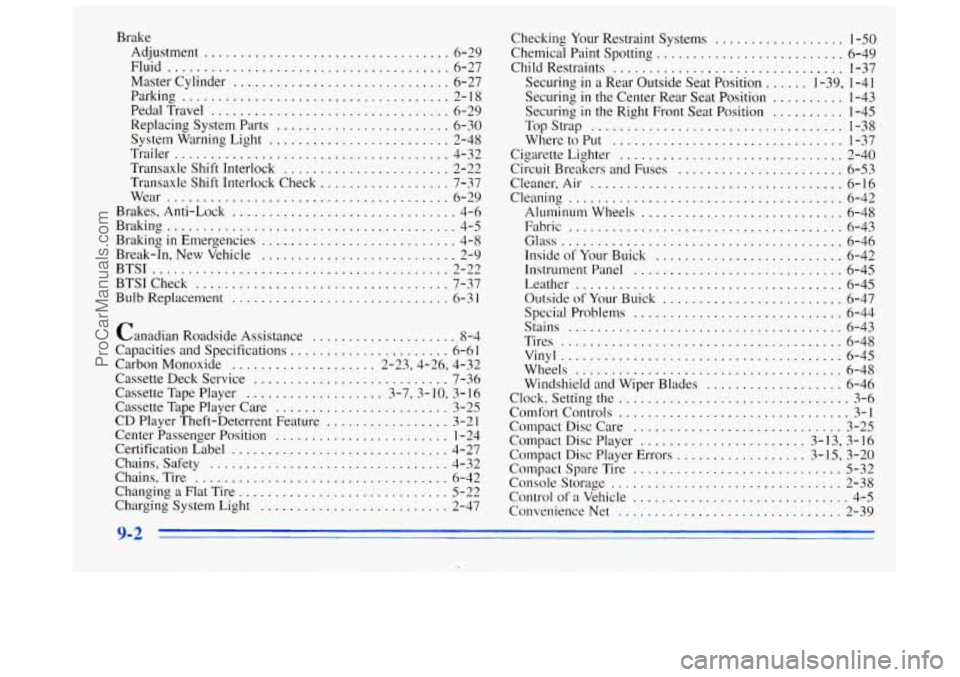
Brake Adjustment
.................................. 6-29
Fluid
....................................... 6-27
Master Cylinder
.............................. 6-27
Parking
..................................... 2-1 8
PedalTravel
................................. 6-29
Replacing System Parts
........................ 6-30
System Warning Light
......................... 2-48
Trailer
...................................... 4-32
Transaxle Shift Interlock
....................... 2-22
Transaxle Shift Interlock Check
.................. 7-37
Wear
....................................... 6-29
Brakes, Anti-Lock
............................... 4-6
Braking
........................................ 4-5
Break-In, New Vehicle
........................... 2-9
Bulb Replacement
.............................. 6-3 1
Braking in Emergencies ........................... 4-8
BTSI
......................................... 2-22
BTSICheck
................................... 7-37
Canadian Roadside Assistance
.................... 8-4
Capacities and Specifications
...................... 6-6 I
Carbon Monoxide .................... 2-23,4-26, 4-32
Cassette Deck Service
........................... 7-36
Cassette Tape Player
................... 3-7,3-10, 3-16
Cassette Tape Player Care
........................ 3-25
CD Player Theft-Deterrent Feature
................. 3-2 1
Center Passenger Position ........................ 1-24
Certification Label
.............................. 4-27
Chains, Safety
................................. 4-32
Chains, Tire
................................... 6-42
Changing
a Flat Tire ............................. 5-22
Charging System Light
.......................... 2-47 Checking
Your Restraint Systems
.................. 1-50
Chemical Paint Spotting .......................... 6-49
Child Restraints
................................ 1-37
Securing
in a Rear Outside Seat Position ...... 1-39. 1-41
Securing in the Center Rear Seat Position .......... 1-43
Securing
in the Right Front Seat Position .......... 1-45
TopStrap
................................... 1-38
Where to Put
................................ 1-37
Cigarette Lighter
............................... 2-40
Circuit Breakers
and Fuses ....................... 6-53
Cleaner. Air
................................... 6-16
Cleaning ...................................... 6-42
Aluminum Wheels
............................ 6-48
Fabric
...................................... 6-43
Glass
....................................... 6-46
Inside of Your Buick
.......................... 6-42
Instrument Panel
............................. 6-45
Leather
..................................... 6-45
Outside
of Your Buick ......................... 6-47
Special Problems
............................. 6-44
Stains
...................................... 6-43
Tires
....................................... 6-48
Vinyl ....................................... 6-45
Wheels
..................................... 6-48
Windshield and Wiper Blades
................... 6-46
Clock. Setting the
................................ 3-6
Comfort Controls
................................ 3-1
Compact Disc Care
............................. 3-25
Compact: Disc Player ....................... 3- 13. 3-16
Compact Disc Player Errors
.................. 3- 15. 3-20
Compact Spare Tire
............................. 5-32
Console Storage
................................ 2-38
Control
of a Vehicle .............................. 4-5
Convenience Net
............................... 2-39
ProCarManuals.com
Page 353 of 356

Spare Tire. Compact ............................. 5-32
Specifications and Capacities
...................... 6-6 I
Specifications. Engine ........................... 6-62
Speech Impaired. Customer Assistance
............... 8-3
Speedometer
................................... 2-45
SRS
......................................... 1-18
Stains. Cleaning
................................ 6-43
Starter Switch Check
............................ 7-37
Starting Your Engine
....................... 2- 1 I. 2- 12
Steam
........................................ 5-12
Steering
....................................... 4-8
Column Lock Check
.......................... 7-38
In Emergencies ................................ 4-9
Power ....................................... 4-8
Tips
......................................... 4-8
Variable Assist
................................ 4-8
Wheel. Tilt
.................................. 2-25
Steering Wheel Touch Controls
.................... 3-23
Storage Compartments
........................... 2-38
Storage. Vehicle
................................ 6-30
Stuck:
In Sand. Mud. Ice or Snow .................. 5-33
Sunvisors
.................................... 2-40
Supplemental Restraint System
.................... 1 - I8
Symbols. Vehicle
.................................. x
System Controls. Electronic Climate Control .......... 3- 1
Tachometer .................................. 2-45
Taillamp Bulb Replacement
....................... 6-32
Tape Player Care
............................... 3-25
Temperature Control. Passenger
.................... 3-2
Theft
.......................................... 2-7
Theft-Deterrent Alarm System
..................... 2-8 Theft-Deterrent Feature.
CD Player
................ 3-21
Thermostat
.................................... 6-24
Third Gear. Automatic Transaxle
................... 2-16
Tilt Steering Wheel
............................. 2-25
Time. Setting the
................................ 3-6
Tire-Loading Information Label
................... 4-27
Tires
......................................... 6-34
Alignment and Balance
........................ 6-40
BuyingNew
................................. 6-38
Chains
...................................... 6-42
Changing a Flat
.............................. 5-22
Cleaning
.................................... 6-48
Compact Spare
............................... 5-32
Inflation .................................... 6-35
Inflation Check
............................... 7-35
Inspection and Rotation
........................ 6-36
Loading
.................................... 4-27
Pressure
.................................... 6-35
Storing the Flat
............................... 5-30
Storing the Spare
............................. 5-31
Temperature
................................. 6-39
Traction
.................................... 6-39
Treadwear
................................... 6-39
Uniform Quality Grading
....................... 6-38
Wear Indicators
.............................. 6-37
Wheel Replacement
........................... 6-40
When It’s Time for New
....................... 6-37
TorqueLock
................................... 2-21
Torque, Wheel
Nut ......................... 5-29, 6-61
Towing a Trailer ................................ 4-29
Towing Your Vehicle
............................. 5-7
THEFTLOCK
TM ................................ 3-21
TopStrap
..................................... 1-38
9-9
ProCarManuals.com